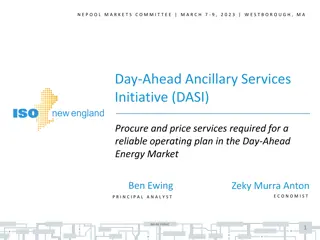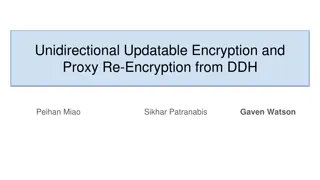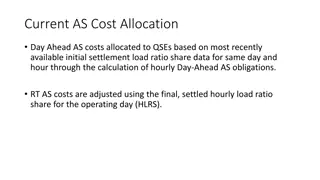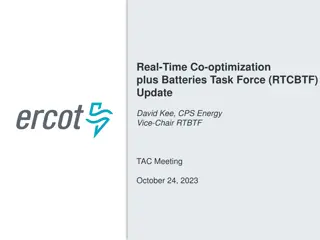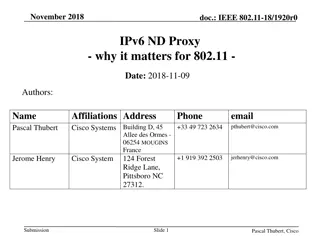
ERCOT Proxy Ancillary Service Offer Parameters Discussion
"Explore the discussion on proxy Ancillary Service Offer parameters in ERCOT meetings, including floors, historical behavior, and recommendations for Real-Time Co-optimization. Learn about feedback from market participants and considerations for setting floor values. Stay informed on the evolving process in the energy sector."
Download Presentation

Please find below an Image/Link to download the presentation.
The content on the website is provided AS IS for your information and personal use only. It may not be sold, licensed, or shared on other websites without obtaining consent from the author. If you encounter any issues during the download, it is possible that the publisher has removed the file from their server.
You are allowed to download the files provided on this website for personal or commercial use, subject to the condition that they are used lawfully. All files are the property of their respective owners.
The content on the website is provided AS IS for your information and personal use only. It may not be sold, licensed, or shared on other websites without obtaining consent from the author.
E N D
Presentation Transcript
Parameters for Proxy Ancillary Service Offer Floors 2nd Discussion David Maggio Principal, Market Design & Analytics RTCBTF October 22, 2024
Recap of the September ERCOT Presentations At the last meeting in September, ERCOT staff had two presentations to get discussion going on proxy Ancillary Service Offer floors: A refresher on the Ancillary Service Offer structure and process for creating the proxy Ancillary Service Offers under Real-Time Co-optimization (RTC). This included the role of the proxy Ancillary Service Offer floor. A presentation looking at analyses of: Energy Offer Curve (EOC) behavior and proxies being created as part of that existing proxy process; and Historically Ancillary Service Offer behavior, where the historical offers available would be those primarily used for the Day-Ahead Market (DAM). 2 ERCOT Public
Recap of the September ERCOT Presentations cont. ERCOT recommendation during the previous meeting was that a value of $0/MW per hour be used for the proxy offer floor parameter with the reasons being: Risks that exist for the DAM that may warrant high Ancillary Service Offers in the Day-Ahead, such as Resource availability uncertainty, don t exist in Real-Time. Resource availability and capabilities are known in Real-Time and are being provided through telemetry by the Qualified Scheduling Entity (QSE). A proxy Ancillary Service Offer considers the floor values, QSE offers for that same product, and QSE offers for other Ancillary Services that the Resource is qualified to provide. The floors primarily come into play only when no offer is submitted by the QSE for the Resource at all. Under RTC, a QSE has the ability to update Real-Time Ancillary Service Offers through the Operating Hour. This is in addition to other tools available to the QSE, such as Ancillary Service capability telemetry. 3 ERCOT Public
Feedback During the September Meeting A group of market participants provided feedback during the task force meeting suggesting that the floor should be set at the System-Wide Offer Cap (SWCAP), e.g., $2,000/MWh for Real-Time under RTC. The commenters largely pointed to the existing proxy EOC process as justification. At a high-level, the proxy EOC process under RTC works as follows: For Resources without any EOC that are not Intermittent Renewable Resources (IRRs), there is a proxy EOC going from -$250/MWh to $2,000/MWh at a MW value equal to the Resource s Output Schedule. For IRRs without any EOC, there is a proxy EOC going from -$250/MWh to $1,500/MWh at a MW value equal to the Resource s High Sustained Limit (HSL). For non-IRRs and IRRs without a full-range EOC, the EOC is extended using the highest submitted offer. There are some similar rules for Energy Storage and Controllable Load Resources (ESRs and CLRs). Some concern was already raised about market participants being unaware of the potential for Ancillary Service awards. 4 ERCOT Public
Thoughts Following the Task Force Discussion The proxy Ancillary Service offer is the maximum of: The proxy floor (the parameters being discussed); The highest submitted Ancillary Service Offer price for that product; and In certain cases, the highest submitted Ancillary Service Offer price for other products. The effect of having a floor at SWCAP is that all proxy Ancillary Service Offers will be at the SWCAP. The other parts of the equation are not used or relevant anymore. This is not really equivalent to the current EOC process. 5 ERCOT Public
Thoughts Following the Task Force Discussion cont. Having proxy Ancillary Service Offers at the SWCAP could make the proxy process for Ancillary Services ineffective and, in some circumstances, entirely useless. For Non-Spinning Reserve Service (Non-Spin), the majority or entirety of the Ancillary Service Demand Curve (ASDC) is currently expected to be less than SWCAP. Under an SWCAP proposal, proxy offers can t be awarded and might as well not exist. For ERCOT Contingency Reserve Service (ECRS), depending on the Ancillary Plan, this same concern exists to a smaller degree (i.e., less of the ASDC is typically below SWCAP). This concern of being short on reserves is not applicable to Regulation Reserves (Reg-Up/Reg-Down) or Responsive Reserve Service (RRS) based on the current ASDCs, but these products would be impacted by an SWCAP proposal with ramped in ASDCs. These points are focused on unwarranted Ancillary Service shortages and not Ancillary Service costs. While certain proxy EOCs are at SWCAP, Resources with those EOCs can be dispatched with limited (current) or no (under RTC) shortage in actually meeting demand (i.e., power balance). 6 ERCOT Public
RTC Simulation Tool Illustration: June 20, 2023 Snapshot of ASDC for 12:00 Real-Time SWCAP under RTC For any portion of an ASDC under the dotted line, an Ancillary Service offer at SWCAP cannot be awarded to meet that portion of the Ancillary Service. 7 ERCOT Public
RTC Simulation Tool Illustration: June 20, 2023, cont. Proxy Offer Floor = $2,000/MW per hour Proxy Offer Floor = $0/MW per hour Energy Prices Energy Prices Limited scarcity and lower prices Limited scarcity and lower prices Ancillary Service Prices Ancillary Service Prices Limited scarcity and lower prices High prices and lower awards 8 ERCOT Public
RTC Simulation Tool Illustration: June 20, 2023, cont. Proxy Offer Floor = $2,000/MW per hour RTC Non-Spin Awards Proxy Offer Floor = $0/MW per hour RTC Non-Spin Awards 3,678 MW 1,278 MW Similar decreased levels of Non-Spin awards occur across evening hours, during periods of higher total scarcity and system-wide pricing, which is an intended outcome of RTC. However, with proxy offer floors set to SWCAP, lower levels of Non-Spin awards are observed during periods with high levels of available reserves (e.g., at 12:00 total Operating Reserve Demand Curve (ORDC) reserve were >15 GW and PRC > 6 GW). Award differences were largely for dispatchable Resources. 9 Note: The thin line of Solar is 0 across all hours in both cases ERCOT Public
RTC Simulation Tool Illustration: June 20, 2023, cont. Proxy Offer Floor = $2,000/MW per hour RTC ECRS Awards Proxy Offer Floor = $0/MW per hour RTC ECRS Awards 2,519 MW 2,117 MW Similar decreased levels of ECRS awards occur across evening hours, during periods of higher total scarcity and system-wide pricing, which is an intended outcome of RTC. However, again, with proxy offer floors set to SWCAP, lower levels of ECRS awards are observed during periods with high levels of available reserves (e.g., at 12:00 total ORDC reserve were >15 GW, PRC > 6 GW). Again, award differences were largely for dispatchable Resources. 10 Note: The thin line of Solar is 0 across all hours in both cases ERCOT Public
Conclusions It s true that ERCOT s recommendation for proxy Ancillary Service Offer floors creates a process that is not fully equivalent to the proxy EOC process. This is specifically true for the no offer condition. Proxy Ancillary Service Offer floors at SWCAP are also not equivalent to current proxy EOCs. In looking at initial analysis, proxy Ancillary Service Offer floors at SWCAP seem inappropriate, as they create unwarranted shortages in procurement and scarcity pricing for Ancillary Services in conditions of relatively high reserves. While not directly comparable, DAM Ancillary Service prices for June 20, 2023, were also not elevated during the middle of the day. At a minimum, any proposals that deviate from the initial ERCOT recommendation should not create significant, unwarranted shortages. 11 ERCOT Public
Questions, Additional Discussion, and Next Steps ERCOT Public


